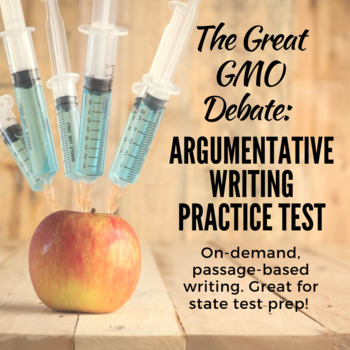The Great GMO Debate: Argumentative Writing Practice - Made with Google!
- Google Docs™

Description
Looking to prepare your students for a state writing test or the ACT writing test? Searching for a real-world relevant topic to aid your students in building argumentative writing skills? This is the unit for you!
Are genetically modified foods cause for concern in America? Should food companies label genetically modified foods to warn consumers? How has the fear of genetically modified foods impacted American economics, politics, and culture? What should the Department of Health and Human Services should do about the public’s fear of genetically modified food?This unit allows students to examine the topic from multiple perspectives and craft an argument based on evidence from extensive article study.
This instructional resource supports the teaching of on-demand argument writing by teaching students to read and quickly select evidence from multiple sources, develop a claim, and write an argument of policy. This resource is designed to support independent on-demand writing with strategies for scaffolding students’ reading and writing.
This resource is designed around a few key things to remember about on-demand writing:
- Students need instruction and practice to be successful in on-demand tasks
- Students must practice effective outlining, organization, and planning skills to develop effective arguments
- A compelling opening makes a big difference
- Practice with introducing and commenting on quotations is critical for students writing source-based arguments
- Conclusions have to move beyond the introduction
Skill Emphasis
- Read and respond to several sources representing a range of perspectives in a conversation around a single issue.
- Quickly construct a nuanced claim & support with evidence from nonfiction sources.
What does this resource include?
- Text sets to provide students with evidence to support their arguments
- A step-by-step unit guide that gives a minute-by-minute breakdown of each activity.
- Four argumentative-writing activities that help students explore, evaluate, and articulate their perspectives while collaborating with peers
- Optional graphic organizers to help struggling students
Thank you for supporting this Oklahoma teacher mom! All proceeds from my Teachers Pay Teachers profits go to paying for my four-year-old son's martial arts lessons, my baby girl's recent birth medical expenses, and paying down debt from years of buying my own school/classroom supplies. Please continue supporting my work by following me on TpT and Facebook (Page Name: Adventures with Mrs. Anderson: Oklahoma Curriculum Designer)!
Before Purchasing:
- Licensing - Please remember this is a single use license. If you plan to share with a grade level, please purchase the multiple use license at check out. This is a small add-on that allows me to continue making great resources. If you are an administrator purchasing this product for school use, please purchase the school license. This product may not be shared via email, shared drive, hard copy, or school website.


